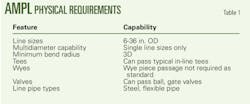A new technology allows multiple pig launching with existing pipeline equipment.
Aging pipeline networks and the installation of new lines over greater distances and in more hostile environments have heightened demand for pigging technology. Pipeline pigging is essential for removing debris and collecting sample fluids, ensuring flow is maintained and corrosion minimized. Pigging, however, is time consuming and can disrupt production and operational efficiency.
The UK oil Industry's Technology Facilitator issued a call for technology proposals to increase production capacity and efficiency. Participants identified reliable flow-assurance techniques as critical. This article details field testing of a technology developed by Pipeline Engineering & Supply Co. Ltd. in response to the ITF's call for proposals.
AMPL
The Automatic Multiple Pig Launching System is a new multipigging tool designed by PE. It uses existing pipeline equipment, retrofitted with a cassette loaded with independently launchable pigs. AMPL requires neither modification to existing pipeline launchers nor an external power supply.
Existing automatic pig launchers generally operate a complex arrangement of kicker lines and valves or release flaps for multiple launching. The latter mechanism cannot be retrofitted to existing traps and often requires an external power supply. The complexity of the design can also add substantially to the cost of a launcher.
Opening a trap closure also has health, safety, and environmental implications. These issues become even more complex when pigging from an unmanned platform or during a remote subsea operation. Mechanisms built into the pigs rather than the launcher control pig launching by AMPL, negating the need for human intervention and reducing the intensity and risk of regular pigging activities.
ITF worked with PE to secure industry support from four of its member companies for an AMPL Joint Industry Project to be carried out in two phases. Following successful completion of Phase 1, PE secured further support for two sets of field trials to assess the overall system performance and functionality and gain further understanding of the bypass systems on individual AMPL tools.
JIP participants used a 10-in. AMPL system for the first set of field trials, recently completed at the Petrofac facility in Montrose, Scotland. These trials successfully launched and received the AMPL pigs at flow velocities of 0.5 m/sec and 1 m/sec (14,000 and 28,000 b/d, respectively). The pigs launched successfully and confirmed tests previously undertaken at PE's North Yorkshire base to test and validate AMPL's setup before mobilization to the Montrose base.
Montrose test
The AMPL system cassette was loaded with three suitably configured pigs. Earlier flow tests had shown this configuration to be successful at launching individual pigs with the fluid flow rate set to 0.5 m/sec. Fig. 1 shows data produced from this multiple launch test.
This first test demonstrated the AMPL system launching while the pipeline was operating at 14,129 b/d. Both flow rate and pressure ~15 barg were established in the pipeline before testing. Loading a lead AMPL pig and two standard AMPL pigs into the launch cassette preceded loading the cassette into the pig launcher.
Opening Valve V1 (Fig. 2) flooded the launcher and brought it to operating pressure. Opening Valve V2 allowed product flow through the launcher, cassette, and pigs. Closing Valve V3 diverted flow through the launcher. At about 300 sec the lead pig launched and was confirmed by the pig signaler, product was allowed to continue flowing through the trap for an additional 300 sec to test for unplanned pig launch. None occurred. Reversing this process depressurized the trap.
The trap remained depressurized for about 400 sec but at no point was it drained or opened. At around 1,000 sec repressurization occurred and the valves operated in the same manner as for the lead AMPL pig. At about 1,400 sec launch of the second AMPL pig happened, again confirmed by the pig signaler. The trap remained flooded after once again being depressurized.
During the launch of the second AMPL pig, detectors signaled receipt of the lead pig. Isolating and draining the receiver to retrieve the pig confirmed only the lead pig had launched. The receiver was flooded and repressurized ready for receipt of the second AMPL pig.
At around 3,200 sec, technicians pressurized the launcher again, operating the valves by the same process as the first two pigs. Launch detection of the final AMPL pig occurred at about 3,500 sec, confirming individual launch of each the AMPL pigs. During the launch of this final pig, the receipt of the second AMPL pig was detected. Immediately retrieving the pig confirmed its individual launch.
The pipeline continued operating until around 5,000 sec when the final AMPL pig was detected and retrieved in the receiver. The pipeline was shut down and data retrieved.
The next stage of field trials will take place in Oman, where AMPL will be tested in an 8-in. OD oil pipeline about 9 km long and currently under a fortnightly pigging schedule.
The author
More Oil & Gas Journal Current Issue Articles
More Oil & Gas Journal Archives Issue Articles
View Oil and Gas Articles on PennEnergy.com







